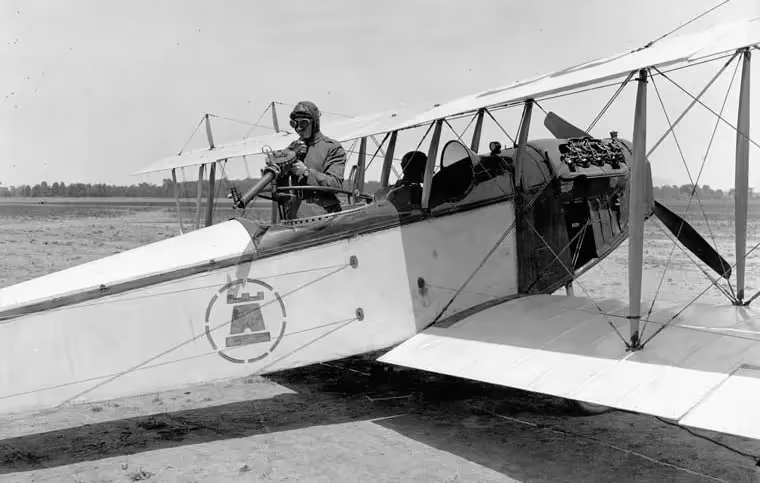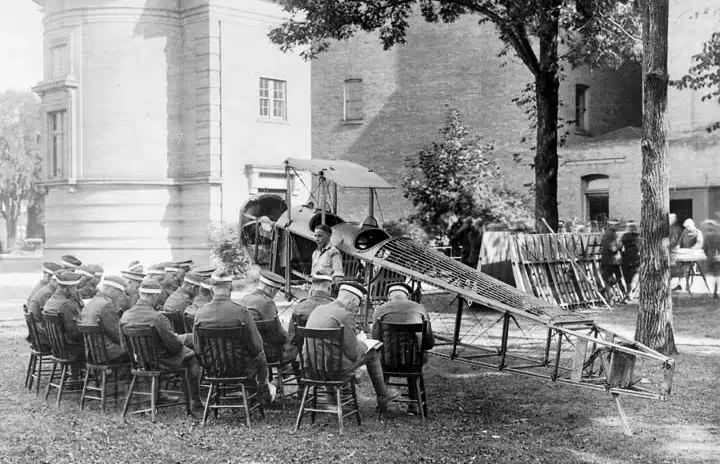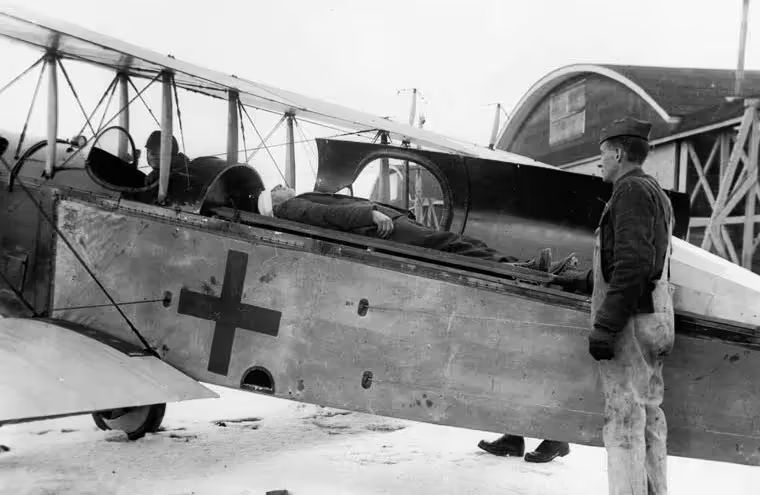Canadian Warplanes 2: Curtiss JN-4 Canuck
Curtiss JN-4 Canuck and Jenny biplanes

(Library and Archives Canada Photo, MIKAN No. 3390046)
Curtiss JN-4 Canuck, Royal Flying Corps, over Camp Borden, Ontario, 1917.
Curtiss produced the JN-4, with orders from both the US Army and an order in December 1916 from the Royal Flying Corps (RFC) for a training aircraft to be based in Canada. The Canadian version, the JN-4 (Canadian), also known as the Canuck, had some differences from the American version, including a lighter airframe, ailerons on both wings, a bigger and more rounded rudder, and differently shaped wings, stabilizer, and elevators.
1,260 JN-4s were built by Canadian Aeroplanes Ltd. for the RFC in Canada/RAF in Canada and USAAC. Its use by the USAAC was curtailed as the lighter structure was claimed to cause more accidents than the US-built aircraft, although no air fatalities were attributed to the structural integrity of the type.
The British used the JN-4 (Canadian), along with the Avro 504, for their primary First World War trainer using the Canadian Aeroplanes Ltd. variant. Many Royal Flying Corps pilots earned their wings on the JN-4, both in Ontario and later in winter facilities at Camp Taliaferro, Texas. Although ostensibly a training aircraft, the Jenny was extensively modified while in service to undertake additional roles.
Due to its robust but easily adapted structure able to be modified with ski undercarriage, the Canadian Jenny was flown year-round, even in inclement weather. The removable turtle-deck behind the cockpits allowed for conversion to stretcher or additional supplies and equipment storage, with the modified JN-4s becoming the first aerial ambulances, carrying out this role both during wartime and in later years. Most of the 6,813 Jennys built were unarmed, although some had machine guns and bomb racks for advanced training. With deployment limited to North American bases, none saw combat service in the First World War. (Wikipedia)

(City of Vancouver Archives Photo, AM640-S1-: CVA 260-2057)
Curtiss JN-4D trainer, ca 1918.

(Library and Archives Canada Photo, MIKAN No. 12163)
Curtiss JN-4, July 1915.

(Library and Archives Canada Photo, MIKAN No. 3199848)
Curtiss JN-4 Canuck (Serial No. C184) of the Royal Flying Corps Canada, at Camp Taliaferro, 1917.

(RMC Museum Photo)
08 Apr 1917. Cadet James Harold Talbot born in Buffalo, New York, on 22 Jul 1893, to Canadian parents, died of injuries sustained in the crash of a Curtiss JN-4 flown by pilot instructor 2Lt G.C. Husband at Camp Borden. Talbot was the first military fatality in Canada . The aircraft was a complete write-off. The JN-4 apparently over turned and the student was thrown against the airframe resulting in severe injuries which included a fractured skull. The pilot, although injured, survived the accident. Talbot had enrolled in the Royal Flying Corps on 23 Jan 1917. Both men were members of No. 81 Canadian Reserve Squadron which was formed on 21 Mar 1917. The squadron was one of five that made up No. 42 Wing of the Royal Flying Corps Canada. The first group of cadets had only just arrived in Borden; the official opening of the aerodrome was scheduled for 2 May 1917. (https://www.canada.ca/en/department-national-defence/maple-leaf/rcaf/migration/2017/james-talbot-a-noble-young-life.html)

(Library and Archives Canada Photo, MIKAN No. 4274264)
Pilot boarding a Curtiss JN-4 Canuck, c1918.

(Library and Archives Canada Photo, MIKAN No. 3263321)
Curtiss JN-4, 13 June 1915.

(Library & Archives Canada Photo, MIKAN No. 3194479)
Curtiss JN-4, C332, in flight.

(Library & Archives Canada Photo, MIKAN No. 3390045)
Four US Army Curtiss JN-4D training aircraft in formation, ca 1918.

(Library and Archives Canada Photo, MIKAN No. 3390048)
Curtiss JN-4, C282, Ottawa, 26 Aug 1918.

(Library and Archives Canada Photo, MIKAN No. 3390073)
Curtiss JN-4, C282, Winnipeg, Toronto, 27 Aug 1918. This aircraft carried the first airmail in Canada.

(Library and Archives Canada Photo, MIKAN No. 3408621)
Curtiss JN-4, Victory Loan Parade, 1917.

(Library and Archives Canada Photo, MIKAN No. 3408632)
Curtiss JN-4, Victory Loan Parade, 1918.

(Library and Archives Canada Photo, MIKAN No. 3390042)
Curtiss JN-4, Long Branch, Ontario, 13 Oct 1915.

(Library and Archives Canada Photo, MIKAN No. 3404547)
RFC Canada, School of Aerial Gunnery, Curtiss JN-4 with Scarfe Mounting for Observer's Training. Beamsville, Ontario, 1918.

(Library and Archives Canada Photo, MIKAN No. 3404197)
Curtiss JN-4 aircrew gunnery training, Camp Borden, 1917.

(Library and Archives Canada Photo, MIKAN No. 3404272)
Curtiss JN-4 Lewis Gun, aerial gunnery training, Camp Borden, 1917.

(Library and Archives Canada Photo, MIKAN No. 3404263)
Curtiss JN-4 with .303-inch Vickers Machine Gun mounted for training, School of Aerial Gunnery, Beamsville, Ontario, 1918.

(Library and Archives Canada Photo, MIKAN No. 3404264)
RFC Canada. C.C. Gear (Synchronized Machine Guns) on Curtiss J.N-4. School of Aerial Gunnery, Beamsville Camp, Ontario, 1918.

(Library and Archives Canada Photo, MIKAN No. 3404168)
Curtiss JN-4 with synchronized .303-inch Vickers MG, Camp Borden, 1917.

(Photo courtesy of the Canadian Aviation Preservation Association)
Curtiss JN-4D, No. 13.

(Library and Archives Canada Photo, MIKAN No. 3390052)
Curtiss JN-4, RFC, School of Aerial Gunnery, Camp Beamsville, Ontario, 1918.

(Photo courtesy of the Canadian Aviation Preservation Association)
Curtiss JN-4D.

(Author Photo)
Curtiss/Canadian Aeroplanes JN-4 Canuck, RFC (Serial No. C1347), G-CAAI, G-CATE, "City of Edmonton". Reynolds Aviation Museum, Wetaskiwin, Alberta.

(Library and Archives Canada Photo, MIKAN No. 3390051)
Curtiss JN-4s fitted with skis, Camp Leaside, Ontario, 1917.

(Library and Archives Canada Photo, MIKAN No. 3404496)
Curtiss JN-4s fitted with skis, Camp Leaside, Ontario, 1917.

(Library and Archives Canada Photo, MIKAN No. 3194478)
Lecture on rigging, using a Curtiss JN-4 Canuck, No. 4 School of Aeronautics, University of Toronto, Ontario, ca. 1917.

(Library and Archives Canada Photo, MIKAN No. 3194478)
Class on construction using a Curtiss JN-4 fuselage, No. 4 School of Aeronautics, University of Toronto, Ontario, ca. 1917.

(Library and Archives Canada Photo, MIKAN No. 3404213)
Class on construction, Hart House, No. 4 School of Aeronautics University of Toronto, Ontario, 1917-18. Sopwith Camel, RAF B.E.2, RAF F.E.2 Gunbus, Curtiss JN-4, de Havilland D.H.4.

(Library and Archives Canada Photo, MIKAN No. 3404545)
Curtiss JN-4 used as an air ambulance, Camp Leaside, Ontario, RFC, 1918.

(Library and Archives Canada Photo, MIKAN No. 3404546)
Curtiss JN-4 used as an air ambulance, Camp Leaside, Ontario, RFC, 1918.

(DND Archives Photo, PL-113903)
Curtiss JN-4 Canuck.

(Library and Archives Canada Photo, MIKAN No. 3388454_
Curtiss JN-4 Canuck, possibly Royal Flying Corps, at Long Branch, Toronto, Ontario, 10July 1915.

(Photo courtesy of the Canadian Aviation Preservation Association)
Curtiss JN-4D Canuck, G-CYDC.
Curtiss JN-4 Canuck (Jenny), (10) Registration Nos. G-CYCN, G-CYCO, G-CYCP, G-CYDC, G-CYDD, G-CYDE, G-CYDF, G-CYDG, G-CYDV, and G-CYDW.

(Deseronto Archives Photo)
Curtiss JN-4 (Serial No. C696). On the tail is a castle symbol, indicating that this was the training aircraft used by Vernon Castle at Camp Mohawk, one of the Royal Flying Corps' pilot training camps near Deseronto, Ontario, 1 Jan 1917.

(Library and Archives Canada Photo, MIKAN No. 3232843)
Curtiss JN-4 trainers, Camp Mohawk, Ontario, c1917-1918.



(Author Photos)
Curtiss JN-4 Canuck (Serial No. C227), ex 39158, ex 111, CASM.

(Library and Archives Canada Photo, MIKAN No. 3390056)
Curtiss JN-4 Canuck, ready for flight, Canadian Aeroplanes Ltd., Toronto, Ontario, 1917.

(Library and Archives Canada Photo, MIKAN No. 3390060)Curtiss JN-4 Canuck (Serial No. C318), equipped with snow skids, ready for flight, Canadian Aeroplanes Ltd., Toronto, Ontario, 1917.

(Rkonigs Photo)

(Daderot Photo)
Curtiss JN-4 Canuck exhibit in the Glenbow Museum, 130 9th Ave S.E., Calgary, Alberta.





